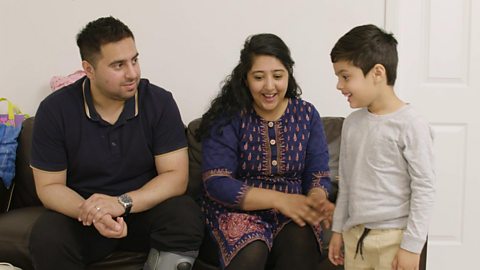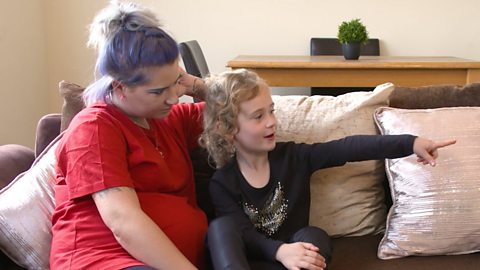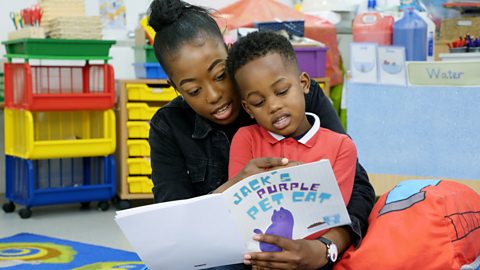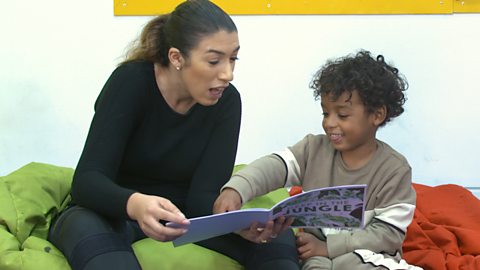Did you know that there are loads of language learning benefits that come along with a game of hopscotch?
Playing hopscotch with letters is a fun way to help your child with their understanding of letter sounds, which is a really important skill when learning to read and write.
Check out the video below to see how our families have adapted this classic playground game to help their children have fun with phonics.
What letter's that?
b for butterfly!
Yeah! We're going to draw a hopscotch, yeah?
Yeah!
Let's go!
What we need to do is throw the stone onto each of the letters, and then we're going to try and think of something that begins with that letter
.a for apple!a for apple.
Ready, steady…Go.
Uh oh!
Right. Don't worry. Let's try again. Okay.Good lad.
Right, so throw it gently. So what letter is that?
d.d.d.d.
So jump onto a.
a!
Then onto b and c.
b!
Then onto d.
d.
What begins with d?
Dog.
A dog? Yeah! And what does a doggy do?
Woof woof!
Woof woof! What can you think of that begins with a j?
Jelly!
Jelly! It goes wibble wobble.
Right, shall I have a go? Get the stone. Good lad.
Thank you.e.e.e.
What animal begins with e? And it does this.
Elephant.
That's right. Good lad. That was a good one!
Right, let's hop over. What letter's that?
k for kitchen.
k for kitchen. i is for…Iguana!
That's it.Good lad, and then jump on the next one. That's it. Winner!
Can I give you a high five?
Yeah.
Can I have a high five?
Yeah.
High five? [Laughs]
What are the benefits of playing hopscotch with letters?
- It is a fun way for your child to learn the sounds in words.
- Getting them to tell you a word that begins with a specific letter sound boosts their early reading skills.
- Playing hopscotch introduces lots of new words and phrases into a child's vocabulary, such as 'balance', 'steady yourself', 'aim carefully'.
- Talking about hopping allows you to introduce prepositions, like over and above, into your conversation.
- Following the rules of hopscotch challenges listening and understanding skills.
- Hopscotch is a game that involves taking turns, cooperating with and being considerate of others.
How hopscotch can help early reading
Playing hopscotch with letters teaches your child about the starting letter sounds in words.
At around four to five years old, children begin to understand that words are made up of smaller sounds. To learn to read, children need to develop an awareness of these small sounds.
So by asking your child to think about the letter sounds they're landing on in hopscotch and getting them to tell you a word that begins with this sound, you are helping their early reading skills, as they are connecting the letter they see to words they know.
Find out more about what phonological awareness is and why it's such an important part of language development.
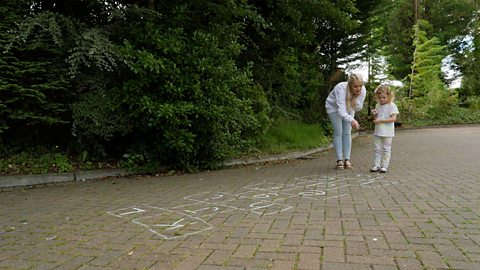
How to play hopscotch with letters
Hopscotch is such a simple game to play and you don't need very much to set it up either. Play with your child one-on-one, or with multiple people.
Talk your child through the rules and be patient. There are a lot of elements that they need to remember and it might take them a while to understand.
Be mindful of your child's ability. If they are struggling with any aspect of the game, you can offer them alternatives and help them build up to a full version through practice.
You will need:
- Chalk
- A small object, like a stone, to throw
- A place to draw your hopscotch squares

What to do:
1. Draw a traditional hopscotch diagram, like the ones shown in the video above.
2. Fill the squares with either letters or pictures.
3. Get your child to throw their small object so that it lands on a square. If they miss, just reassure them and let them try again.
4. Before they move, ask them to name a thing beginning with the letter sound in the square. If you are using pictures, can they tell you which letter-sound the picture starts with?
5. Your child must then hop or jump on each of the squares until they reach the one that their small object is on.
6. When they reach their square, pick it up and keep going until they reach the end of the hopscotch board.
7. Keep playing and talking about all the different letters or pictures with your child and expanding their vocabulary as you go.
Keep adapting the play as your child gets more advanced. You could add a new rule for them to learn, or ask them to name more than one object at a time.

